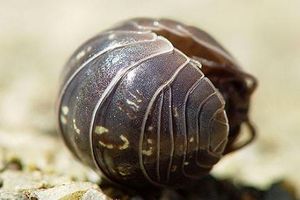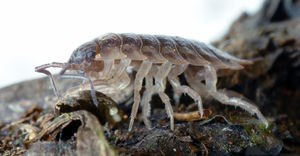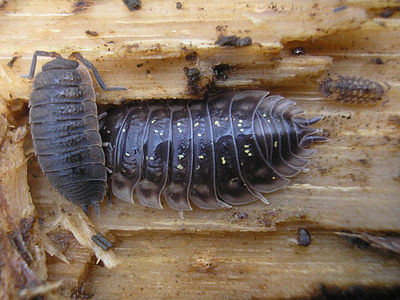Isopods
Classification:
Kingdom: Animalia
Clade: Euarthropoda
Sub-Phylum: Crustacea
Class: Malacostraca
Order: Isopoda

Characteristics of Isopods
Isopods are a broad order of animals that range from marine parasites to soil- dwelling mesofauna and macrofauna. Isopods typically have an elongated body that is relatively flat with segmented plates across their back. They are similar to insects because they both have heads, thoraxes, and abdomens. The heads (sometimes called cephalons) have compound eyes, two pairs of antennae, and four sets of jaws. Typically the upper pair of antennae on isopods are chemosensory structures while the lower pair of antennae are used as feelers. All isopods have sessile eyes which means they are directly on the body and are not connected via a stem or stalk. Their midsection is called their thorax (sometimes called pereon) and is the central part of their body. Additionally, the midsection consists of seven segments, after the first where the head is fused to the thorax. Typically, terrestrial isopods (Woodlice) have a pair of legs attached to each segment of the thorax. The legs consist of flexible joints that are used for moving. The tail end section of an isopod is called the abdomen (or pleon) and is where the tail segments of their chitinous plates are located. The abdomen usually consists of six plates; five of which are simply used as defensive plates that can curl into a ball and another pointed plate that functions as a tail to help maneuver in water. Underneath these plates are flattened gills that are used to aid the isopod in respiration and other body functions.
Terrestrial Isopods
Isopods that have fully transitioned to being terrestrial organisms are in the suborder Oniscidea which consists of around 5,000 species. Colloquial names for terrestrial isopods are pill bugs, sowbugs, potato bugs, and woodlice. They are typically found in the O-Horizon of soil and on top or under fallen trees on the forest floor. Predators of isopods range from beetles to foxes and even some species of owls. Due to the isopods' nutrient-high diet, they are a great addition to many predators' diets as well. With this reasoning, they are an important part of the ecosystem as both detritivores that aid in the decomposition of vegetation and as a food source for other species. Isopods create a high content of organic matter that is added to the soil from litter fragmentation.

Soil Toxicity in Relation to Isopods
Terrestrial isopods can be detritivores. They are known to remove heavy metals such as copper, cadmium, lead, and zinc from the soil. Furthermore, they have been used in studies to discover the degree of metal contamination within soil. It has been noted that low concentrations of copper in isopods have been shown to stimulate the growth rate in juveniles while high concentrations of copper spurt growth in isopods. Certain species of isopods have been known to distinguish between plant leaves with high cadmium sulfate levels and avoid eating them.
When there are high levels of any metal in an isopod, it may be because the metal is in the litter rather than the soil itself. This is because their digestion system is the main route of contamination, and territorial isopods eat leaf litter more frequently than any other food source. Most field studies will only use isopods for metal contamination as opposed to contamination from organic chemicals because of their eating habits and since there is no standardized test with isopods to test toxicity. This is because there are multiple ways for isopods to uptake toxins, like through the soil itself as compared to their food, and it is difficult to decipher where the toxin has come from. They also have a longer and more complex life cycle when comparing other more commonly used creatures used to test toxicity like springtails and earthworms.
Isopods Diet
Isopods can fall into one or more of the following feeding niches: detritivores, browsers, carnivores, parasites, and filter feeders.
Aquatic isopods always fall in the filter feeder or parasite niche. The filter feeders will eat dead plant material and algae off of stones and logs that reside on the bottom of bodies of water. Parasitic isopods are external blood feeders that reside in fish buccal cavities and shrimp and crab gill cavities.
Terrestrial isopods are generally herbivores and can fall under all categories of feeding niches described. They eat a range of materials that include moss, bark, algae, fungi, and decaying material (including leaf litter.) The fungi on some trees provide amounts of nitrogen that isopods need in their diet.
References
1. Tree of Life Isopoda. (n.d.). . http://tolweb.org/Isopoda/6320/1997.08.06.
2. Ddblade. (n.d.). . https://www3.northern.edu/natsource/INVERT1/Pillbu1.htm.
3. Magrini, M. J., A. V. L. Freitas, and M. Uehara-Prado. 2011. The effects of four types of anthropogenic disturbances on composition and abundance of terrestrial isopods (Isopoda: Oniscidea). Zoologia (Curitiba) 28:63–71.
4. Cortet, J. C. A. C. B., A. G.-D. Vauflery, N. Poinsot-Balaguer, L. Gomot, C. Texier, and D. Cluzeau. 1999. The use of invertebrate soil fauna in monitoring pollutant effects. European Journal of Soil Biology 35:115–134.
5. Brigić, A., I. Antonović, A. Alegro, V. Šegota, and J. Bujan. 2017. Terrestrial isopods (Isopoda: Oniscidea) as unexpected inhabitants of extreme habitats. European Journal of Soil Biology 82:66–71.
6. Hattenschwiler, S., S. Buhler, and C. Korner. 1999. Quality, Decomposition and Isopod Consumption of Tree Litter Produced under Elevated CO 2. Oikos 85:271.
7. van Gestel, Cornelis A M, et al. “Terrestrial Isopods as Model Organisms in Soil Ecotoxicology: A Review.” ZooKeys, U.S. National Library of Medicine, 3 Dec. 2018, https://www.ncbi.nlm.nih.gov/pmc/articles/PMC6288250/#B43.
